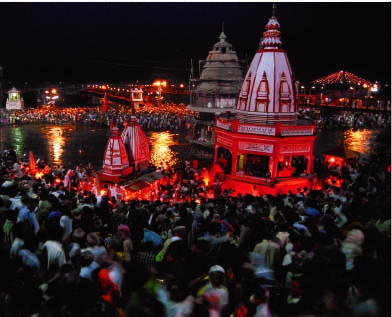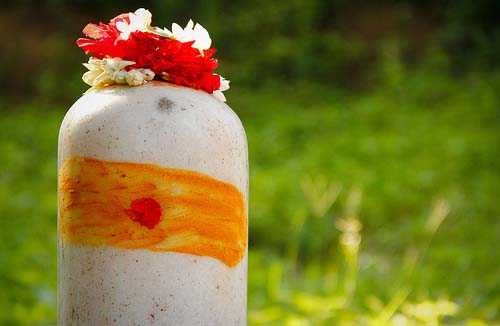
Mahasivaratri – “Himself Creates. Himself Preserves. Himself Destroys.”
For millions of Hindus Mahasivaratri is a very meaningful day, a day of oneness with the Supreme Being. Why do Hindus observe it? What is the Sivalinga? And do believers fast or feast on this day? If you’ve ever wondered what the different rituals signify, the editors of Hinduism Today share an all-comprehensive report with readers of Lassi with Lavina, dispelling the myths and clarifying the power behind this observance.
Mahasivaratri is the most important festival dedicated to Lord Siva. This holy day is observed by millions of Hindus all over the world. It is one of Hinduism’s most esoteric holy days, when yoga practices, mantras and meditation take the devotee closer to God’s essence within the core of himself. Hindus typically fast, maintain silence and stay up all night to perform spiritual practices, such as worshiping, chanting and singing. In some regions, devotees visit as many Siva temples as they can on this night.

Who is Siva?
For hundreds of millions of Hindus Siva is the Supreme Being, the absolute One God who both transcends creation and pervades it–thus existing as our own innermost essence. Siva is the powerful Deity whose energetic dance creates, sustains and dissolves the universe in endless cycles. He is the master yogi delving into unfathomable mysteries, the supreme ascetic, the prime mystic, the Light behind all light, the Life within all life. Siva is often called Mahadeva, “Great Being of Light,” for He created other, lesser Gods such as Ganesha and Karttikeya. Although Siva is usually depicted as male, in reality God and the Gods are beyond gender and form, as depicted by His half-male, half-female form, Ardhanarishvara. Parvati, regarded as Siva’s consort in village Hinduism, is mystically understood as His manifest energy, inseparable from Him. The ancient Tirumantiram scripture says of Siva, “Himself creates. Himself preserves. Himself destroys. Himself conceals. Himself all of this He does and then grants liberation–Himself the all-pervading Lord.”
What happens on Mahasivaratri?
Many Hindus perform an all-night vigil, plunging the soul into its own essence, led by Siva, the supreme yogi, who is both the guide and the goal of the search. Staying awake through the night is a sacrifice and a break from life’s normal routine, a time out of time to be with God within, to reach for the realization of our true, immortal Self. Siva is known as Abhisheka Priya, “He who loves sacred ablutions,” and thus many temples and home shrines have water always dripping on the Sivalinga. On this special night, Sivalingas are bathed with special substances, sometimes several times. Mahasivaratri occurs on the night before the new moon in February/March.

Photo Credit: Natesh Ramasamy via Compfight cc
What is the Sivalinga?
Linga means “mark, token or sign.” A Sivalinga, representing Siva, is found in virtually all of His temples. The Sivalinga is the simplest and most ancient symbol of the Divine. It is especially evocative of Parasiva, God beyond all forms and qualities, the unmanifested Absolute. Sivalingas are commonly made of stone, but may also be of metal, precious gems, crystal, wood, earth or even transitory materials like sand or ice. Ardent devotees make special Sivalingas to worship during Mahasivaratri.
Is there a special mantra for Siva?
Namah Sivaya is among the foremost Vedic mantras. It means “adoration to Siva” and is called the Panchakshara, or “five-letters.” The five elements, too, are embodied in this ancient formula for invocation. Na is earth, Ma is water, Si is fire, Va is air, and Ya is ether, or space.
Mahasivaratri: Holy Ash, Bilva Leaves & the Kumbh Mela
What is holy ash? Holy ash is a sacrament that is dear to devotees of Siva. Taken from sacred fires, it purifies and blesses those who wear it. This fine, white powder is worn on the forehead as a reminder of the temporary nature of the physical body and the urgency to strive for spiritual attainment and closeness to God.
What is the special offering to Siva? Hindus believe that offering bilva leaves (Aegle marmelos) on Mahasivaratri is most auspicious. Legend tells of a hunter who was chased by a tiger. Scrambling up a thorny tree, he plucked and dropped its leaves to stay alert. The tree was a bilva, The leaves happened to fall on a Sivalinga, and it was the night of Sivaratri. That all-night worship of God, though inadvertent, earned the hunter liberation from rebirth. Siva accepts devotees irrespective of their faults and foibles, forgiving man’s cognizant and innocent mistakes.
What is the Kumbha Mela? The Kumbha Mela is a grand festival held every few years in rotation at four places where several sacred rivers converge: Haridwar, Prayag, Nasik and Ujjain. The largest melas, at Haridwar and Prayag, fall in January to April and often include Mahasivaratri. Devotees come from near and far to immerse themselves in the holy waters, with prayers for purification and spiritual liberation on their lips. In 2001, the Kumbha Mela at Prayag, held on the river bank, was attended by more than 60 million people. It was the biggest human gathering held on Earth, seven times the population of New York City.
Fasting & Silence
While virtually every Hindu festival comes with a sumptuous list of foods to feast on, during Mahasivaratri most Hindus fast. A spiritual practice found in almost all of the world’s religions, fasting calms the physical, mental and emotional energies, helping the devotee draw nearer to the ineffable Self within. While the most strict fast on nothing but water; others permit themselves fruits, milk or rice.
Many observe silence on this night, thinking of nothing but God. Silence, known in Sanskrit as mauna, quiets the demands of the mind and body, bringing forth spiritual clarity.
In Hinduism, God is not separate from creation. A virtuous life and certain techniques, such as yoga and ascetic practices, allow a person to remove the veil that makes us think of ourselves as separate from Him.
Fact & Fiction
FACT: Hindus undergo numerous traditional rites of passage at critical junctures throughout life. These ceremonies invoke divine blessings for the individual and help bind him with his community as he advances on the path of virtue. Name-giving, first feeding, commencement of learning, coming of age, marriage and cremation are primary examples.
FICTION: It is commonly believed that rituals are mandatory. In fact, there are no absolute requirements within Hinduism. Each devotee is free to practice his faith according to his family tradition and personal preferences.
(Text courtesy: Hinduism Today)
Related Article and photo gallery

1 Comment
Via the Lassi with Lavina page on Facebook
https://www.facebook.com/LassiwithLavina
Parul Thecakedesigner Patel, Shago Perkins, Lavika Bhagat S and 8 others like this.